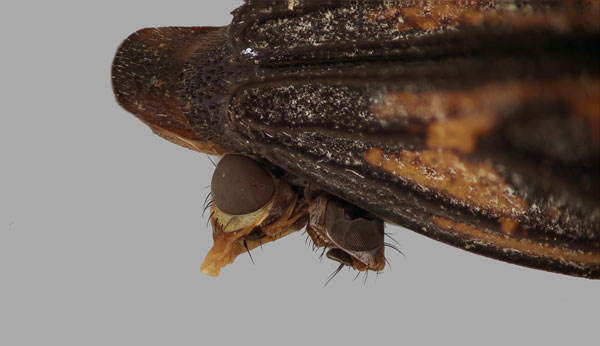The response to the jewel beetle field guide has been incredible thus far, with nearly 900 people requesting more than 1300 copies in less than 2 weeks! With all this attention to beetles around here lately, I figured I’d post a little reminder about which insect order still rules these parts.

Proof that 2 parasitic heads are more gruesome than 1. Parasitic flesh/satellite flies (Sarcophagidae) forever entombed as they attempt a late emergence from the abdomen of a captured Buprestis consularis jewel beetle. Photo by Adam Jewiss-Gaines.
We came across this little tragedy while examining and photographing specimens for the field guide, and Adam Jewiss-Gaines did a great job of bringing their sorry plight to life (so to speak) in this image-stacked photo.
I tried to track down what species (or even subfamily) these flies may be, but I couldn’t find any record (in my admittedly quick search) of sarcophagids using Buprestidae as hosts. According to the Manual of Nearctic Diptera Vol. 2, these little guys likely belong to the subfamily Miltogramminae (based on their seemingly bare arista), which are commonly known as satellite flies for their habit of orbiting ground nesting bees and wasps and kleptoparasitizing their collected prey, but I’m unsure whether they will parasitize free-living beetles. If they are in fact members of the Sarcophaginae (some of whom do have bare arista), perhaps these individuals are members of the genus Sarcophaga, species of which have been reared from beetles and various other insects.
Without being able to examine the rest of their bodies, I may never know what these flies are, but I find it fascinating that they matured and began their escape only to be killed and preserved within our collection!
While we’re talking about flesh flies, I want to call your attention to some absolutely amazing Scanning Electron Micrographs of male sarcophagid genitalia taken by my friend Dave Cheung. Not only are the genitalia bizarre and the micrographs beautiful, but Dave has worked his magic and made them both zoomable and rotatable, creating pseudo-3D models! Check them out — I guarantee they’ll blow your mind!
UPDATE Dec. 17, 2012: Never mind about this being a free-living beetle! I double checked the specimen label, and this beetle was actually collected from a Cerceris fumipennis colony in Highland Hammock State Park, Florida, which almost certainly makes these Miltogramminae satellite flies.
Information regarding Sarcophagidae biology was taken from SarcoWeb, a website created and maintained by Dr. Thomas Pape which is dedicated to the study of flesh fly taxonomy.

Interesting – I don’t recall off hand any records for sarcophagid parasitoids associated with Buprestidae – two in one is even more interesting. I did a quick search through my database, and the only endoparastic fly association with Buprestidae that I found was Sarcophaga sp. associated with Buprestis aurulenta, so this is probably an unknown association. Digger wasps are, of course, the most commonly natural enemy association, followed distantly by a variety of ichneumonoid, encyrtoid, and chalcididoid parasitoids.
Interesting Ted! After re-checking the specimen this morning I realized this wasn’t actually a free-living beetle, but rather one collected from a Cerceris fumipennis nest, so that should be noted. Be sure to be on the lookout for satellite flies and emergences next time your working Cerceris nests!
That’s good to know, because although satellite flies are well associated with Cerceris funipennis no specific association with buprestid beetles has been reported. You’ll want to make sure this gets into a publication of some sort.
And the evolution of parasitism in Calypterata get’s yet more complicated for me. Right now, in our analyses, we’re seeing Rhinophoridae and Pollenia (Calliphoridae) as sister groups to Tachinids, though in other inferences it’s Mesembrinella (Calliphoridae). Which means the parasitoid habit has probably evolved twice if not more in that lineage. So, what is it about calypterates that predisposes them to being parasitoids? First thought, their ‘basal’ association with fleshy habitats. Given that parasitoid calypterates tend not to have braconid like specialism, at least in tachinids form a physical respiratory funnel to get around the host’s immune system, it seems like a relatively easy jump from an accidental parasitism to an obligate one. Or not.
That’s gruesomely amazing! Cool shot.
Only because of Ted’s excellent posts on buprers dropped around Cerceris nests, but I wondered that when you id’d it as a miltogrammine. Neat.